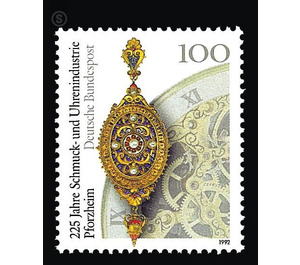225 years jewelry and watch industry pforzheim - Germany / Federal Republic of Germany 1992 - 100 Pfennig
Theme: Devices, Items & Instruments
| Country | Germany / Federal Republic of Germany |
| Issue Date | 1992 |
| Face Value | 100.00 |
| Color | olive white |
| Perforation | K 13 3/4: 14 |
| Printing Type | Multicolor offset printing |
| Stamp Type | Postage stamp |
| Item Type | Stamp |
| Chronological Issue Number | 1501 |
| Chronological Chapter | GER-BRD |
| SID | 396990 |
| In 42 Wishlists | |
The foundation stone for the jewelry and watch industry in Pforzheim was laid in 1767 by Margrave Karl Friedrich von Baden. The nucleus of the Pforzheim jewelry industry was watchmaking. In a grand edict of April 6, 1767, the Frenchman Jean François Autran was initially allowed the establishment of a pocket watch factory. Due to a margrave privilege followed in November of the same year, the expansion of the watch factory for jewelry and steel products factory. The main reasons, which caused the settlement of clock and jewelry enterprises in Pforzheim, lay with the Waisenhauszoglingen. So are 10 articles of the founding treaty of education and training. The margrave funds for the first entrepreneurial actions were at the same time a social aid for the orphans. Soon after the margrave's founding of the watch and jewelery manufactory, the private entrepreneurial initiative provided for expansion: Pforzheim became "the most important factory town in the Margraviate of Baden", and abroad, one also spoke respectfully of "Little Geneva". That Pforzheim could take this upswing in a short time, is also the traffic-favorable situation of the city. For one thing, Pforzheim lay on the west-east axis, the major link leading from Paris to Prague; On the other hand, they reached the north-south axis from Frankfurt am Main via Pforzheim to Ulm an der Donau. This transportation hub made traveling easier, and thus distribution channels, for the emerging jewelry and watchmaking industry. Countries like Austria, Switzerland and France, but also Belgium and the Netherlands were not too far away from Pforzheim. Also the visit of the most important exhibition places like Frankfurt, Leipzig and Vienna was possible in only few days. In the eventful 225-year history of the Pforzheim jewelry and watch industry, the trade routes opening at that time played a significant role until today. The traditional industries are still extremely export oriented - their products are sold in over 160 countries around the world. The gold town of Pforzheim - as the center of the German jewelry and silverware industry - is a meeting point for buyers of jewelery and watches from all over the world. As a specialist purchaser, the permanent sample exhibition informs you about the world's largest permanent exhibition for jewelery, watches and fine equipment. And anyone who is interested in the history of jewelery will be looking for the internationally unique jewelry museum in the Reuchlinhaus. However, those who decide to train in the professions of the jewelery and watch industry visit the Goldsmith School with a watchmaking school or the College of Design, both of which are educational establishments of international standing. (Text: Industrieverband Schmuck und Silberwaren, Pforzheim)


